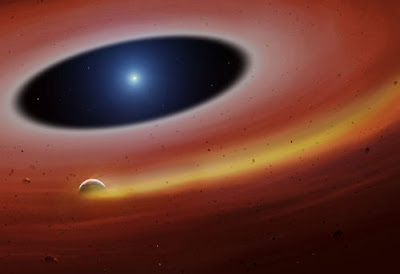 |
| An artist's impression of the planetesimal orbiting on a 2-hour period within the gaseous disc around SDSS J1228+1040 (by Mark Garlick). |
Topics: Astronomy, Astrophysics, Exoplanets, Spectrograph, White Dwarfs
When the hydrogen fuel that keeps a star like our sun burning brightly is exhausted, the star expands into a red giant before collapsing into a hot, dense white dwarf. Although the stellar swelling engulfs nearby planets, theoretical models suggest that some planets and planetary cores up to hundreds of kilometers in diameter can survive the star’s death and fall into closer orbit. But identifying solid bodies around a dim stellar core is difficult. Now Christopher Manser (University of Warwick) and colleagues have used a new spectroscopic method to identify a planetesimal orbiting a white dwarf 400 light-years from our solar system.
Astronomers have discovered most exoplanets—including an asteroid-like body orbiting a white dwarf—via the transit method, identifying periodic dimming as an object passes in front of its host star. But the method requires a lucky geometry of the planetary system’s orbital plane relative to Earth. Manser and his team instead turned to short-cadence optical spectroscopy using data from the 10.4 m Gran Telescopio Canarias in Spain. They focused on one of just a few white dwarfs that, based on metal emission lines in the stellar and disk spectra, are suspected to be surrounded by disks of gas and dust. Minute-by-minute observations over several nights in 2017 and 2018 let the researchers deconstruct the light emanating from the disk and determine how much variation had occurred over a year.
A glimpse of a planetary system’s final stages, Rachel Berkowitz, Physics Today